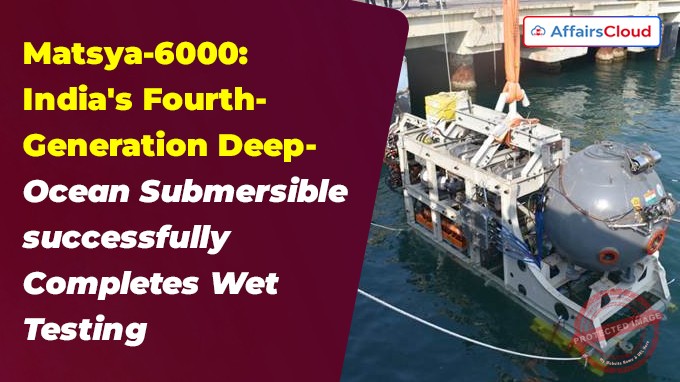 On February 17 2025, India’s 4th-generation deep-ocean submersible ‘Matsya-6000’ successfully completed its wet testing at L&T Shipbuilding facility in Kattupalli Port, Chennai (Tamil Nadu, TN).
On February 17 2025, India’s 4th-generation deep-ocean submersible ‘Matsya-6000’ successfully completed its wet testing at L&T Shipbuilding facility in Kattupalli Port, Chennai (Tamil Nadu, TN).
- It was developed and tested by the National Institute of Ocean Technology (NIOT), Chennai under the Samudrayaan Project, and was designed for deep-sea exploration and scientific research.
Pre-Testing Phase:
Before undergoing wet testing, Matsya-6000 completed dry tests at a 500 m operational range to assess the integration and performance of the submersible, ensuring its readiness for more advanced trials.
Wet Testing:
i.From January 27 to February 12, 2025, Matsya-6000 underwent wet testing at Kattupalli Port, involving 8 dives: 5 unmanned and 3 manned.
ii.The tests focused on key performance parameters, such as power control, buoyancy, stability, maneuverability, safety, and the functionality of its scientific instruments.
Note: The successful wet testing strengthens confidence that Matsya-6000 will be ready for shallow-water demonstrations at depths of up to 500 meters by the end of 2025, marking a significant milestone in India’s deep-sea exploration capabilities.
Key Features of Matsya-6000:
i.Matsya-6000 is engineered to accommodate 3 crew members in its 2.1-meter (m) diameter (d) spherical hull.
ii.It is built to withstand the immense pressure at deep-sea depths for scientific research, exploration, and industrial purposes.
iii.Key features include a ballast system for controlled diving, thrusters for movement in all directions, a battery bank for power supply, syntactic foam for buoyancy, and advanced control systems for navigation.
iv.It also has communication systems, such as an acoustic modem, underwater telephone, Very High Frequency(VHF) for surface communication and Global Positioning System(GPS) for precise location tracking, along with life-support systems for crew safety and scientific payloads for data collection.
About the Samudrayaan Mission:
i.The Samudrayaan or the deep ocean mission, was initiated in 2021, India’s first manned mission to explore the deep ocean.
- It is part of the larger Deep Ocean Mission (DOM), supporting the Central Government’s Blue Economy policy.
- The nodal ministry for this mission is the Ministry of Earth Sciences (MoES).
ii.It aims to develop a self-propelled manned submersible to carry 3 human beings to a water depth of 6,000 meters in the ocean, equipped with scientific sensors and tools for deep ocean exploration.
iii.The mission is designed to study deep ocean resources and conduct biodiversity assessments without disturbing the ecosystem.
iv.The submersible will be outfitted with a range of scientific sensors and tools, with an operational endurance of 12 hours, extendable to 96 hours in case of an emergency.
About National Institute of Ocean Technology (NIOT):
Director- Balaji Ramakrishnan
Headquarters- Chennai (Tamil Nadu)
Established- 1993




